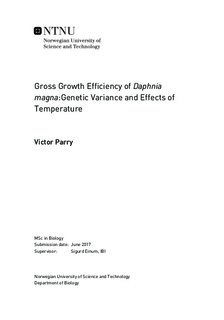Gross Growth Efficiency of Daphnia magna:Genetic Variance and Effects of Temperature
Master thesis
Permanent lenke
http://hdl.handle.net/11250/2447083Utgivelsesdato
2017Metadata
Vis full innførselSamlinger
- Institutt for biologi [2571]
Sammendrag
Gross Growth Efficiency (GGE) is defined as the ratio between Somatic Growth Rate (SGR) and food consumption, and hence represents the quantity of food eaten that is converted to body mass. SGR correlates with intrinsic rate of population increase and GGE may correlate with trophic efficiency. SGR and GGE can provide potential focal traits to link ecology to physiological traits and understanding the genetic and environmental sources of variations and covariations of these traits is important. I compared SGR and GGE of 10 different clones from a single population of the zooplankton Daphnia magna at a single temperature and found significant genetic variation in both traits. This implies that these traits can evolve in a population. However, there was no genetic correlation between SGR and GGE implying that the traits evolve independent of each other. I also measured SGR and GGE of a single clone at eight different temperatures (range 12 - 28°C) and as expected, SGR increased with increasing temperature, and so did GGE. The generality of this latter result remains to be shown across different clones. I suggest that the observed temperature response for GGE is consistent with expected selective pressures in the wild, where negative correlations between temperature and food abundance throughout the season makes it more important to maximize efficiency at high temperatures when food abundance is more likely to be limiting.
